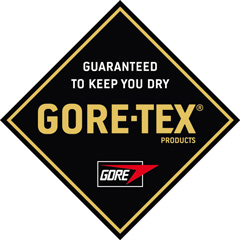
Gore-Tex is a renowned fabric known for its waterproof, windproof, and breathable properties, which has made it a staple in the production of high-end outdoor gear and apparel.
Its unique membrane technology incorporates over 9 billion pores per square inch, which are large enough to allow vapor to pass through yet small enough to block water from outside.
This innovative feature makes Gore-Tex garments highly sought after by outdoor enthusiasts who need reliable protection against extreme weather conditions.
The cost of Gore-Tex products often comes as a surprise to many consumers, owing to the complex manufacturing process and the rigorous research and development that back its production. The incorporation of advanced materials and the need for specialized construction techniques also contribute to the higher prices of Gore-Tex items.
The expense is not just for the material itself but also for the brand’s commitment to quality and its exclusive patent that restricts other manufacturers from producing similar products.
As consumers weigh the cost against the benefits, the question of whether Gore-Tex is worth the investment arises. Its durability, versatility, and unmatched performance in protecting from harsh environmental factors play a significant role.
Gore-Tex’s ability to extend the lifespan of clothing and gear may mitigate the initial cost over time, making it potentially worth it for those who regularly face demanding outdoor conditions.
But let’s explore it in detail!
Contents:
What Is Gore-Tex?
Gore-Tex is a waterproof, breathable fabric membrane known for its ability to repel liquid water (from outside the garment) while allowing water vapor to pass through (from inside the garment).

Gore-Tex® Logo
The Technology Behind Gore-Tex
Gore-Tex is crafted using an advanced membrane technology that involves expanded Polytetrafluoroethylene (ePTFE), which is more commonly known as Teflon. This ePTFE membrane contains over 9 billion microscopic pores per square inch.
These pores are 20,000 times smaller than a water droplet, rendering the membrane impermeable to rain and snow. However, they are 700 times larger than a molecule of water vapor, allowing perspiration to escape and thus maintaining breathability.
Key Features of Gore-Tex:
- Waterproofness: The microscopic pores in the Gore-Tex membrane block the penetration of water from the outside, ensuring you stay dry in wet conditions.
- Breathability: Despite its waterproof nature, Gore-Tex fabric allows the escape of water vapor (sweat), which is essential to keep you comfortable during physical activity.
- Windproofness: Gore-Tex products are also designed to be windproof, which helps preserve warmth by blocking cold air from penetrating the material.
- Durability: The fabric’s construction with a laminated layering system contributes to its long-lasting performance and resistance to wear and tear.
Learn more: What is Gore-Tex® and How Does It Work?
The video will be loaded from YouTube.com, a third party. If you play it, you accept their terms of service, and their use of cookies.
Why is Gore-Tex Expensive?
Gore-Tex products are known for their premium pricing, a reflection of various factors including high material costs, extensive research and development, strong brand reputation, and a robust quality assurance process.
Material Costs
Gore-Tex fabrics involve a complex membrane technology that is both breathable and waterproof. This material is made from expanded polytetrafluoroethylene (ePTFE), which is costly to produce. The ePTFE membrane must be laminated to fabric layers, requiring specialized equipment and precise manufacturing techniques that drive up production costs.
Research and Development
The development of Gore-Tex has been a result of years of scientific research and technological innovation. The brand invests heavily in research and development (R&D) to enhance the performance of its fabric.
These R&D costs factor into the retail price, as consumers are paying for cutting-edge technology in their outerwear.
Brand Value
Gore-Tex carries a strong brand value associated with quality and reliability. The brand’s reputation helps to command a higher price. Consumers recognize and are often willing to pay extra for the durability and performance that come with Gore-Tex products.
Warranty and Quality Assurance
Gore-Tex offers an extensive warranty, promising to keep the wearer dry and protected. The brand’s quality assurance process involves rigorous testing to meet strict standards. This level of quality control ensures longevity, but it also adds to the final cost of the product.
Read also: Gore-Tex® vs DryVent™: Which is Better?
Gore-Tex Quality: Is It Worth It?
Gore-Tex is renowned for its superior performance in outdoor apparel, deriving its value from its exceptional quality in several key aspects.
Performance Compared to Alternatives
Gore-Tex provides a balance of waterproofing and breathability that sets it apart from alternatives. Materials like PVC or coated nylon may offer waterproofing but lack breathability, leading to condensation and discomfort.
Gore-Tex’s membrane contains over 9 billion pores per square inch, allowing water vapor to escape while blocking water (rain, snow) from entering.
- Breathability: Gore-Tex > PVC / coated nylon
- Waterproofing: Gore-Tex = PVC / coated nylon
- Comfort: Gore-Tex > PVC / coated nylon
Durability and Longevity
The longevity of Gore-Tex products is a testament to their durability. The fabric withstands harsh conditions without the loss of waterproof and breathable properties. It doesn’t easily succumb to wear and tear, making it a favorable choice for long-term use in outdoor gear.
- Wear resistance: High
- Lifespan: Longer than many alternatives
The Cost-Benefit Over Time
When evaluating the cost-benefit of Gore-Tex, it’s important to consider the longevity and enduring performance. Although the initial cost is higher, the investment can be justified over time. A comparison of upfront costs versus potential replacements of lesser quality items shows that Gore-Tex may be more cost-effective in the long run.
- Initial cost: Higher than many alternatives
- Replacement frequency: Lower due to durability
- Long-term investment: More cost-effective
Read also: Gore-Tex® vs Dermizax: Which is Better?
Customer Feedback
Customer feedback often highlights Gore-Tex products’ performance and longevity, providing valuable insights into consumer satisfaction and product use.
Assessing Need vs. Want
Customers generally weigh the necessity of Gore-Tex against its price. Those in demanding climates or with outdoor lifestyles often justify the expense, reporting satisfaction with the product’s effectiveness. Others may find the cost outweighs the benefit if their exposure to extreme weather is minimal.
Lifestyle and Use Cases
Feedback varies by activity. Hikers and skiers frequently praise Gore-Tex for its durability and breathability, essential for their active pursuits.
Urban users also find value in Gore-Tex for everyday wear due to its protection against rain and wind, though their use cases might not demand its full potential.
Maintenance and Care
Customers acknowledge that Gore-Tex requires specific care for optimal performance:
- Cleaning: Mild detergent, front-loading washer. Avoid fabric softeners.
- Drying: Tumble dry on warm, and press with a warm iron to rejuvenate water repellency.
- Storage: Clean and completely dry. Store in a breathable bag.
These practices contribute to the longevity of Gore-Tex garments, with many customers reporting their apparel lasting for several years when properly maintained.
Read also: Gore-Tex® vs Texapore Fabric Technology: Which is Better?
